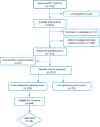Exploring health care professionals' experiences and knowledge of woman-centred care in a university hospital
- PMID: 37405995
- PMCID: PMC10321621
- DOI: 10.1371/journal.pone.0286852
Exploring health care professionals' experiences and knowledge of woman-centred care in a university hospital
Abstract
Inspired by the six quality-of-care goals developed by the Institute of Medicine, woman-centred care (WCC) as model of care is used in maternity services as it gives an emphasis on the woman as an individual and not her status as a patient. Bringing stronger attention to women's needs and values, is proven to have clear benefits for perinatal outcomes, but fails to be known or recognised by healthcare professionals' (HCPs) and implemented. Using a mixed-methods approach, this study aimed to explore HCPs definitions of WCC and identify the degree of agreement and knowledge regarding perinatal indicators when a WCC model of care is implemented. The quantitative part was carried using a self-administered questionnaire with perinatal indicators identified from the literature. Semi-structured interviews were realized using a purposive sample of 15 HCPs and an interview grid inspired by Leap's WCC model. The study was conducted in the maternity of a university hospital in French-speaking part of Switzerland. Out of 318 HCPs working with mothers and their newborns, 51% had already heard of WCC without being familiar with Leap's model. The HCPs were aware of the positive perinatal care outcomes when WCC was implemented: women's satisfaction (99.2%), health promotion (97.6%), HCP's job satisfaction (93.2%) and positive feelings about their work (85.6%), which were strongly emphasised in the interviews. The respondents reported institutional difficulties in implementing the model such as administrative overload and lack of time. The positive outcomes of WCC on spontaneous deliveries and improved neonatal adaptation were known by most HCPs (63.4% and 59.9%, respectively). However, fewer than half of the HCPs highlighted the model's positive effects on analgesia and episiotomies or its financial benefits. Knowledge of quality-of-care outcomes (i.e women's satisfaction, positive impact on practice…) was prevalent among most of HCPs. Without adhering to a common definition and without a specific model for consensus, most providers have integrated some aspects of WCC into their practice. However, specific perinatal indicators remain largely unknown, which may hinder the implementation of WCC.
Copyright: © 2023 Floris et al. This is an open access article distributed under the terms of the Creative Commons Attribution License, which permits unrestricted use, distribution, and reproduction in any medium, provided the original author and source are credited.
Conflict of interest statement
no competing interests
Figures





Similar articles
-
A qualitative study of healthcare professionals' experiences of providing maternity care for Muslim women in the UK.BMC Pregnancy Childbirth. 2020 Jul 10;20(1):400. doi: 10.1186/s12884-020-03096-3. BMC Pregnancy Childbirth. 2020. PMID: 32650735 Free PMC article.
-
The relationship between women-centred care and women's birth experiences: a comparison between birth centres, clinics, and hospitals in Japan.Midwifery. 2012 Aug;28(4):398-405. doi: 10.1016/j.midw.2011.07.002. Epub 2011 Aug 10. Midwifery. 2012. PMID: 21835515
-
Student and educator experiences of maternal-child simulation-based learning: a systematic review of qualitative evidence protocol.JBI Database System Rev Implement Rep. 2015 Jan;13(1):14-26. doi: 10.11124/jbisrir-2015-1694. JBI Database System Rev Implement Rep. 2015. PMID: 26447004
-
Assessing healthcare professionals' experiences of integrated care: do surveys tell the full story?Int J Evid Based Healthc. 2017 Sep;15(3):90-101. doi: 10.1097/XEB.0000000000000116. Int J Evid Based Healthc. 2017. PMID: 28704279 Review.
-
Healthcare professionals' experiences of job satisfaction when providing person-centred care: a systematic review of qualitative studies.BMJ Open. 2023 Jun 9;13(6):e071178. doi: 10.1136/bmjopen-2022-071178. BMJ Open. 2023. PMID: 37295826 Free PMC article.
Cited by
-
How Woman-Centred Care Is Experienced and Understood in Maternity Services by Women and Professionals: A Rapid Review.Scand J Caring Sci. 2025 Sep;39(3):e70086. doi: 10.1111/scs.70086. Scand J Caring Sci. 2025. PMID: 40637288 Free PMC article. Review.
-
Beyond one size fits all: Probing patient choices in gestational diabetes management, from screening to postpartum.Chronic Dis Transl Med. 2024 Oct 25;11(1):33-45. doi: 10.1002/cdt3.153. eCollection 2025 Mar. Chronic Dis Transl Med. 2024. PMID: 40051823 Free PMC article. Review.
References
-
- Institute of Medicine. Crossing the quality chasm: a new health system for the 21st century. Washington, DC: The National Academies Press; 2001. 360 p. - PubMed
-
- Royal College of Midwives (RCM). Position paper No. 4a. Woman-centred care. London: Royal College of Midwives.; 2001.
Publication types
MeSH terms
LinkOut - more resources
Full Text Sources
Miscellaneous

